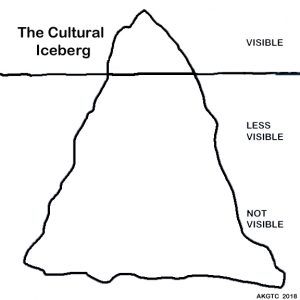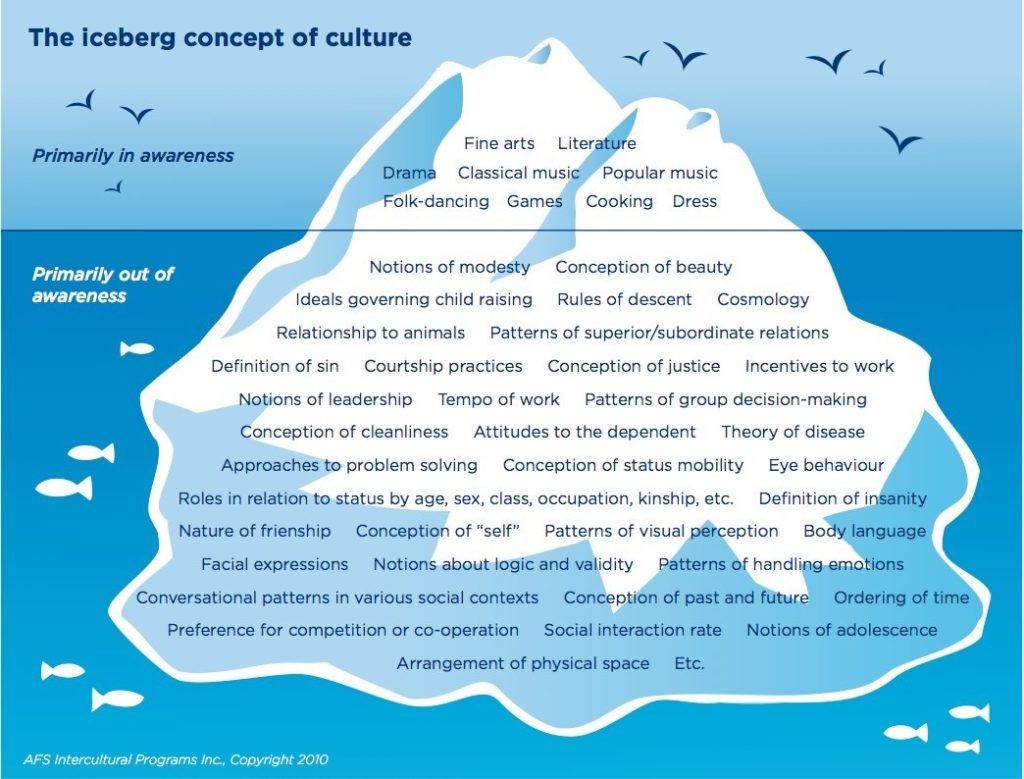


Using the cultural iceberg in our library work Below the waterline of visibility are the things we usually can’t see in others, like education, skills, housing status, wealth and religion. There are also other core values and individual characteristics that are brought to every interaction that we can’t see. (Perhaps you have had an experience in which someone made an incorrect assumption about your age or your gender.) They are sometimes but not always, accurately interpreted. These items above the waterline - such as race, age and gender expression - are what we can observe through looking or listening. You’ll notice that there are aspects of a person that we can see, which we may or may not see accurately because of assumptions we make about appearances. Below the water are many more, rich lived experiences that we can’t see. If each of us were an iceberg, we would only see what’s above the water. The idea of a “cultural iceberg” can help us visualize a person’s lived experiences.
CULTURAL ICEBERG EXAMPLES FREE
In the Free Library of Philadelphia’s Skills for Community-Centered Libraries work, we use the idea of an iceberg to explore this concept.


To communicate clearly, it can be helpful to be aware of the many layers and hidden experiences that impact communication. They also have lenses through which they see the world.Ĭommunity engagement asks us to collaborate with diverse groups of people from our communities, some of whom may have very different life experiences than you. People with whom we’re communicating also have a lived experience that they’re bringing to our interactions. The way people communicate and the beliefs we have are deeply layered our life experiences impact how we connect and communicate with others. It will encourage viewers to collaborate and share knowledge.Communication is complex.
CULTURAL ICEBERG EXAMPLES DOWNLOAD
You can download this slide for team building and process development presentation. The diagram template of explicit & tacit knowledge shows iceberg model and sources of knowledge that fall in each category. This helps develop organization’s knowledge transfer process. It will help distinguish between what can be seen or not in terms of skill learning. The PowerPoint template of Explicit & Tacit Knowledge Iceberg Infographic is useful for organizational knowledge management. On the other hand, tacit knowledge is hidden below the surface and cannot be seen. In the iceberg model, explicit knowledge is a tip of the iceberg that can be seen. The tacit knowledge is personal to each individual’s capacity and experience but explicit knowledge can easily be shared and employed. These may include user manuals, databases, records, and procedure guidelines. Whereas, explicit knowledge is a piece of well-documented information for performing certain actions. Such as education, attitude, insights, and intuitions about context-specific issues. Tacit knowledge is what individuals experience through expertise and job know-how. Knowledge management is divided into two major types in terms of knowledge transfer i.e. This presentation uses the vector-based infographic shape of an iceberg to visualize comparison of explicit and tacit knowledge. The explicit and tacit knowledge could ideally be explained using the similar analogy of iceberg. For example, an iceberg of success, culture, psychology, and organizational behavior. An iceberg analogy is used to describe various concepts where only small part of a much larger idea is visible. The PowerPoint template of Explicit & Tacit Knowledge Iceberg Infographic presents knowledge management concepts using iceberg metaphor.


 0 kommentar(er)
0 kommentar(er)
